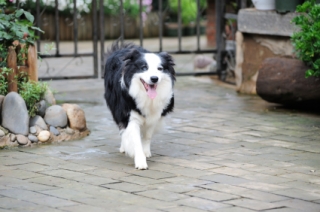The Indoor Dog Ideal

If I said to you that I worked with some dogs whose owner makes them live outside, what is your first thought? I know mine is usually dirty, parasite laden dogs who bark at strangers and don’t care much for being petted. That’s because those are the outdoor dogs I grew up around.
Some imagine that an outdoor dog is sad and lonely, constantly hoping for the chance to come inside. Some imagine a dog on a chain whose world is small and unfulfilling. Depending on where one lives, you might think of the shivering, wet dog who has no shelter while its owners are toasty warm inside.
Few people imagine a dog who is perfectly comfortable in a naturally enriched outdoor environment with adequate shelter and frequent contact with the humans who live inside. We tend to assume that the outdoor dog has no training or manners. We assume a general disconnect between dog and owner along with a lack of empathy and perhaps a lack of general care on the part of the owner.
The truth is, there is no one recipe for the perfect way for all dogs to live. Anyone who has trained dogs in the home knows that a dog being allowed to live inside is no guarantee that the dog is happy, satisfied or better trained. In fact, some horrendous things happen to indoor dogs, as well as outdoor dogs.
A couple of years ago I would have thought what I’m writing is completely crazy. But I’ve come to realize that it is quite possible for many dogs to live really fantastic lives without ever stepping foot inside a home. In fact, for some dogs who have started their life as an outdoor animal, coming inside is absolutely terrifying!
When a trainer goes to a home to work with a client, they ask a lot of questions. They do this because they must find out if the dog’s behavior is due to a lack of enrichment, lack of exercise, presence of health issues or a relationship problem between dog and owner. The answer is usually a combination of some or all of these things.
It would seem only fair to say, then, that dogs who live outdoors would also have different situations that need to be explored before determining what is causing any behavioral issues. I’m not sure that we can assume that living outside is always the issue. In fact, I’m sure that we can’t.
For instance, a dog who lives outside with acceptable digging spots, treat filled toys, chewies, shelter, fresh water and frequent contact with their owner (playing, petting, training) might be behaviorally healthier than the dog who is indoors but free-fed, free-roaming, with no enrichment and contact with their owners that only includes yelling. Being inside the house, by itself, does not change any of the issues that we normally want owners to address.
I’m certainly not suggesting that dogs should live outside. What I’m suggesting is that we could safely expand our definitions for healthy, happy, responsible pet ownership. We start doing that by throwing out our personal criteria for how it “should” be and instead make an honest assessment of how it is. We meet people, and dogs, where they are. We provide suggestions, instructions and solutions for making things better for the unique dog and owner in front of us according to what works for them, not necessarily just pushing them to create a picture that is closer to our own ideal of pet ownership.




